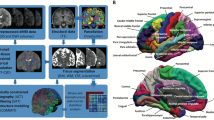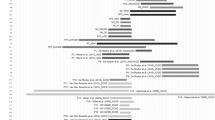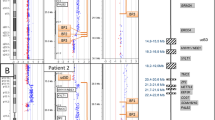Abstract
The pericentromeric region of chromosome 16p is rich in segmental duplications that predispose to rearrangements through non-allelic homologous recombination. Several recurrent copy number variations have been described recently in chromosome 16p. 16p11.2 rearrangements (29.5–30.1 Mb) are associated with autism, intellectual disability (ID) and other neurodevelopmental disorders. Another recognizable but less common microdeletion syndrome in 16p11.2p12.2 (21.4 to 28.5–30.1 Mb) has been described in six individuals with ID, whereas apparently reciprocal duplications, studied by standard cytogenetic and fluorescence in situ hybridization techniques, have been reported in three patients with autism spectrum disorders. Here, we report a multiplex family with three boys affected with autism, including two monozygotic twins carrying a de novo 16p11.2p12.2 duplication of 8.95 Mb (21.28–30.23 Mb) characterized by single-nucleotide polymorphism array, encompassing both the 16p11.2 and 16p11.2p12.2 regions. The twins exhibited autism, severe ID, and dysmorphic features, including a triangular face, deep-set eyes, large and prominent nasal bridge, and tall, slender build. The eldest brother presented with autism, mild ID, early-onset obesity and normal craniofacial features, and carried a smaller, overlapping 16p11.2 microdeletion of 847 kb (28.40–29.25 Mb), inherited from his apparently healthy father. Recurrent deletions in this region encompassing the SH2B1 gene were recently reported in early-onset obesity and in individuals with neurodevelopmental disorders associated with phenotypic variability. We discuss the clinical and genetic implications of two different 16p chromosomal rearrangements in this family, and suggest that the 16p11.2 deletion in the father predisposed to the formation of the duplication in his twin children.
Similar content being viewed by others
Log in or create a free account to read this content
Gain free access to this article, as well as selected content from this journal and more on nature.com
or
References
Betancur C : Etiological heterogeneity in autism spectrum disorders: more than 100 genetic and genomic disorders and still counting. Brain Res 2011; 1380: 42–77.
Kielinen M, Rantala H, Timonen E, Linna SL, Moilanen I : Associated medical disorders and disabilities in children with autistic disorder: a population-based study. Autism 2004; 8: 49–60.
Lupski JR, Stankiewicz P : Genomic disorders: molecular mechanisms for rearrangements and conveyed phenotypes. PLoS Genet 2005; 1: e49.
Kumar RA, KaraMohamed S, Sudi J et al: Recurrent 16p11.2 microdeletions in autism. Hum Mol Genet 2008; 17: 628–638.
Weiss LA, Shen Y, Korn JM et al: Association between microdeletion and microduplication at 16p11.2 and autism. N Engl J Med 2008; 358: 667–675.
Shinawi M, Liu P, Kang SH et al: Recurrent reciprocal 16p11.2 rearrangements associated with global developmental delay, behavioral problems, dysmorphism, epilepsy, and abnormal head size. J Med Genet 2009; 47: 332–341.
Bijlsma EK, Gijsbers AC, Schuurs-Hoeijmakers JH et al: Extending the phenotype of recurrent rearrangements of 16p11.2: deletions in mentally retarded patients without autism and in normal individuals. Eur J Med Genet 2009; 52: 77–87.
Fernandez BA, Roberts W, Chung B et al: Phenotypic spectrum associated with de novo and inherited deletions and duplications at 16p11.2 in individuals ascertained for diagnosis of autism spectrum disorder. J Med Genet 2009; 47: 195–203.
McCarthy SE, Makarov V, Kirov G et al: Microduplications of 16p11.2 are associated with schizophrenia. Nat Genet 2009; 41: 1223–1227.
Walters RG, Jacquemont S, Valsesia A et al: A new highly penetrant form of obesity due to deletions on chromosome 16p11.2. Nature 2010; 463: 671–675.
Jacquemont S, Reymond A, Zufferey F et al: Mirror extreme BMI phenotypes associated with gene dosage at the chromosome 16p11.2 locus. Nature 2011; 478: 97–102.
Ballif BC, Hornor SA, Jenkins E et al: Discovery of a previously unrecognized microdeletion syndrome of 16p11.2-p12.2. Nat Genet 2007; 39: 1071–1073.
Battaglia A, Novelli A, Bernardini L, Igliozzi R, Parrini B : Further characterization of the new microdeletion syndrome of 16p11.2-p12.2. Am J Med Genet A 2009; 149A: 1200–1204.
Hempel M, Rivera Brugues N, Wagenstaller J et al: Microdeletion syndrome 16p11.2-p12.2: clinical and molecular characterization. Am J Med Genet A 2009; 149A: 2106–2112.
Engelen JJ, de Die-Smulders CE, Dirckx R et al: Duplication of chromosome region (16)(p11.2 → p12.1) in a mother and daughter with mild mental retardation. Am J Med Genet 2002; 109: 149–153.
Finelli P, Natacci F, Bonati MT et al: FISH characterisation of an identical (16)(p11.2p12.2) tandem duplication in two unrelated patients with autistic behaviour. J Med Genet 2004; 41: e90.
Bourthoumieu S, Esclaire F, Terro F et al: First prenatally diagnosed case of 16p11.2p12.1 duplication. Prenat Diagn 2008; 28: 254–256.
Bochukova EG, Huang N, Keogh J et al: Large, rare chromosomal deletions associated with severe early-onset obesity. Nature 2010; 463: 666–670.
Tabet AC, Aboura A, Gerard M et al: Molecular characterization of a de novo 6q24.2q25.3 duplication interrupting UTRN in a patient with arthrogryposis. Am J Med Genet A 2010; 152A: 1781–1788.
Glessner JT, Wang K, Cai G et al: Autism genome-wide copy number variation reveals ubiquitin and neuronal genes. Nature 2009; 459: 569–573.
Pinto D, Pagnamenta AT, Klei L et al: Functional impact of global rare copy number variation in autism spectrum disorders. Nature 2010; 466: 368–372.
Hanson E, Nasir RH, Fong A et al: Cognitive and behavioral characterization of 16p11.2 deletion syndrome. J Dev Behav Pediatr 2010; 31: 649–657.
Rosenfeld JA, Coppinger J, Bejjani BA et al: Speech delays and behavioral problems are the predominant features in individuals with developmental delays and 16p11.2 microdeletions and microduplications. J Neurodev Disord 2010; 2: 26–38.
Ren D, Zhou Y, Morris D, Li M, Li Z, Rui L : Neuronal SH2B1 is essential for controlling energy and glucose homeostasis. J Clin Invest 2007; 117: 397–406.
Bachmann-Gagescu R, Mefford HC, Cowan C et al: Recurrent 200-kb deletions of 16p11.2 that include the SH2B1 gene are associated with developmental delay and obesity. Genet Med 2010; 12: 641–647.
Sampson MG, Coughlin 2nd CR, Kaplan P et al: Evidence for a recurrent microdeletion at chromosome 16p11.2 associated with congenital anomalies of the kidney and urinary tract (CAKUT) and Hirschsprung disease. Am J Med Genet A 2010; 152A: 2618–2622.
Barge-Schaapveld DQ, Maas SM, Polstra A, Knegt LC, Hennekam RC : The atypical 16p11.2 deletion: A not so atypical microdeletion syndrome? Am J Med Genet A 2011; 155: 1066–1072.
Zhang Y, Zhu W, Wang YG et al: Interaction of SH2-Bbeta with RET is involved in signaling of GDNF-induced neurite outgrowth. J Cell Sci 2006; 119: 1666–1676.
Acknowledgements
We are grateful to the family for participating in this study. This research was supported by Fondation de France, INSERM and by a donation from Mr Gabriel de Broglie of the Fondation Dehecq-Institut de France. MP is supported by a PhD fellowship from the French Ministry of Research.
Author information
Authors and Affiliations
Corresponding author
Ethics declarations
Competing interests
The authors declare no conflict of interest.
Additional information
Supplementary Information accompanies the paper on European Journal of Human Genetics website
Supplementary information
Rights and permissions
About this article
Cite this article
Tabet, AC., Pilorge, M., Delorme, R. et al. Autism multiplex family with 16p11.2p12.2 microduplication syndrome in monozygotic twins and distal 16p11.2 deletion in their brother. Eur J Hum Genet 20, 540–546 (2012). https://doi.org/10.1038/ejhg.2011.244
Received:
Revised:
Accepted:
Published:
Issue date:
DOI: https://doi.org/10.1038/ejhg.2011.244
Keywords
This article is cited by
-
Characterizing Sleep Problems in 16p11.2 Deletion and Duplication
Journal of Autism and Developmental Disorders (2023)
-
Sex-specific recombination patterns predict parent of origin for recurrent genomic disorders
BMC Medical Genomics (2021)
-
Leptin receptor-expressing neuron Sh2b1 supports sympathetic nervous system and protects against obesity and metabolic disease
Nature Communications (2020)
-
Dose response of the 16p11.2 distal copy number variant on intracranial volume and basal ganglia
Molecular Psychiatry (2020)
-
The effect of copy number variations in chromosome 16p on body weight in patients with intellectual disability
Journal of Human Genetics (2019)



